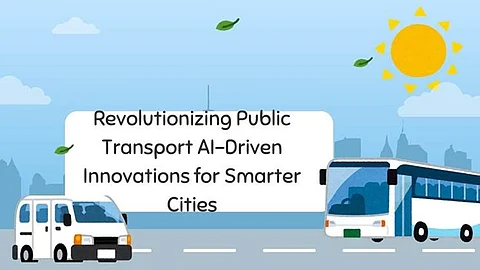

The Future of Urban Mobility With cities expanding at an unprecedented rate, urban transportation networks are facing significant pressure. Traditional systems, designed for smaller populations, are struggling to keep up with rising commuter demands. In response, artificial intelligence (AI) is stepping in to revolutionize transit management and predictive maintenance, transforming urban mobility into a more efficient and sustainable ecosystem.
This article explores the groundbreaking innovations in AI-powered predictive maintenance and intelligent transit management as detailed by Tejeswar Reddy Velpucharla in how machine learning, IoT sensors, and AI-driven optimization are reshaping public transportation.
One such transformational role that artificial intelligence plays in public transport is predictive maintenance. Traditional maintenance schedules depend upon routine intervals or reactive repairs, leading often to unexpected failures and costly disruptions. Alternatively, AI-driven predictive maintenance uses real-time data to predict and prevent potential system failures before their onset.
Transit networks can now leverage artificial intelligence to analyze wear and tear with incredible precision by coupling machine learning algorithms with thousands of embedded sensors. These systems predict failure of the components up to 96 hours in advance, leading to a 71% reduction in unexpected breakdowns and close to a 38% reduction in maintenance costs, resulting in a reliable, cost-effective transportation network with minimum downtime.
Yet another significant innovation has been urban mobility systems controlled by intelligent transit management. They use AI systems to analyze real-time passenger demand, traffic patterns, and environmental factors to optimize routes and schedules. The introduction of dynamic routing to transit authorities has resulted in a 34-percent reduction in passenger wait times and increased overall efficiency of the network by 29 percent.
These things are designed to respond to a changing condition. Automated vehicle dispatching, for instance, cuts idle time; real-time scheduling optimization ensures on-time arrivals. Advanced algorithms also provide potent individualized travel recommendations in order to reach destinations effectively.
The backbone of AI-driven transportation lies in data—lots of it. Modern transit networks generate and process vast amounts of operational data daily. Sophisticated IoT sensor networks monitor track conditions, vehicle health, and passenger movement in real time.
AI models, including neural networks and support vector machines, process this data to detect anomalies, optimize maintenance schedules, and predict service disruptions. Cloud and edge computing play a crucial role in handling these massive datasets, ensuring that decisions are made quickly and efficiently. By reducing unnecessary data transmissions by over 50%, these technologies enhance both performance and cybersecurity.
The role of artificial intelligence in improving public transport systems is changing from merely enhancing the efficiency of these systems to including an even better lifestyle for commuters. Real-time crowd density monitoring can help transit authorities manage passenger flows, resulting in a 35% lower congestion on platforms at peak hours. Predictive analytics could tell passengers more about when their trains will arrive, resulting in reduced gaps in service for improved satisfaction and reductions in missed connections.
Safety, another paramount consideration for AI systems today, is touched upon indirectly through immense operational data streams, which are analyzed to pinpoint potential hazards for pre-emptive action. AI helps provide safer and more robust transport networks, from monitoring infrastructure integrity to detecting unusual vehicle behavior.
Despite the numerous benefits of AI-powered transit systems, their implementation comes with challenges. One of the biggest hurdles is data integration. Public transport networks rely on multiple legacy systems that often lack compatibility with modern AI frameworks. Addressing this requires significant investment in middleware solutions and standardized data protocols.
Another challenge is maintaining system reliability. AI-powered transit networks must process thousands of transactions per second with minimal latency.
Thus, the future of AI-driven transit is very bright. Alongside these emerging technologies, for example quantum computing, which reduces processing time from minutes to seconds, AI offers the power to computer vision systems for monitoring infrastructure and automating defect detection, which also brings a 58% reduction in manual inspections.
Furthermore, ongoing work in blockchain technology for the management of maintenance records will allow more transparency and traceability in those records. Natural language processing in such developments will make passenger interaction more intuitive, which in turn would lead to shorter service response times and increased user satisfaction.
Thus, predictive maintenance and intelligent management of transit powered by AI herald new paths in urban mobility. And these innovations, as Tejeswar Reddy Velpucharla observes, deliver much on reliability, lower costs, and higher passenger satisfaction. Though data integration and cyber security remain issues, the benefits of all these would far outweigh the challenges.
AI solution has arrived at a sustainable and scalable way for modern public transport as an answer to the ever-increasing populations in urban areas. Therefore, embracing these technologies empowers cities with highly resilient, efficient, and passenger-friendly transit networks for the smarter future.
